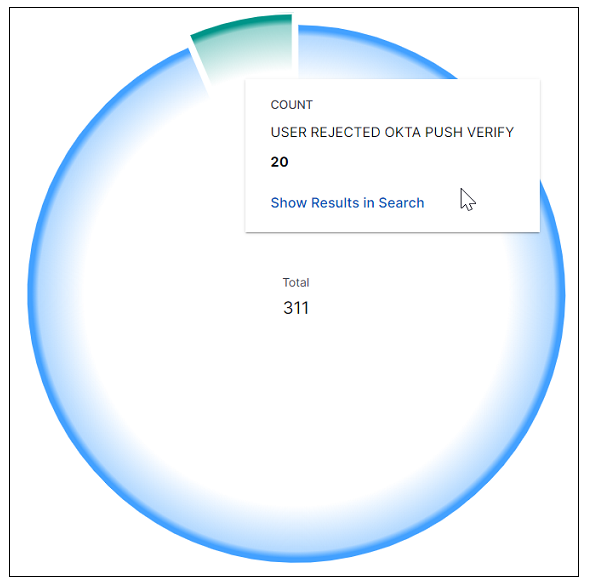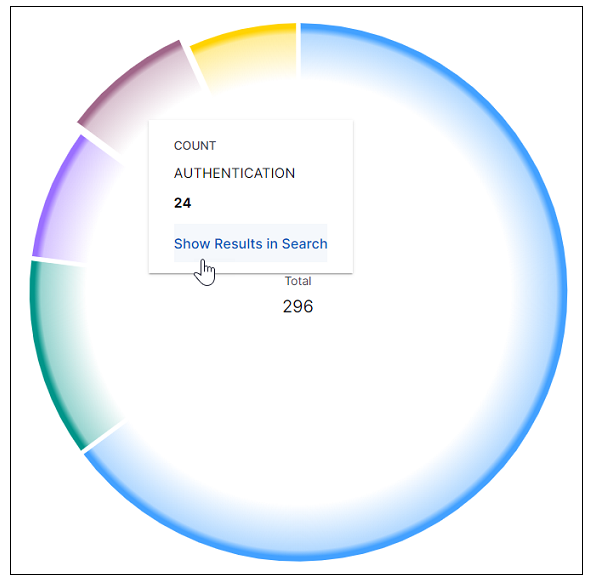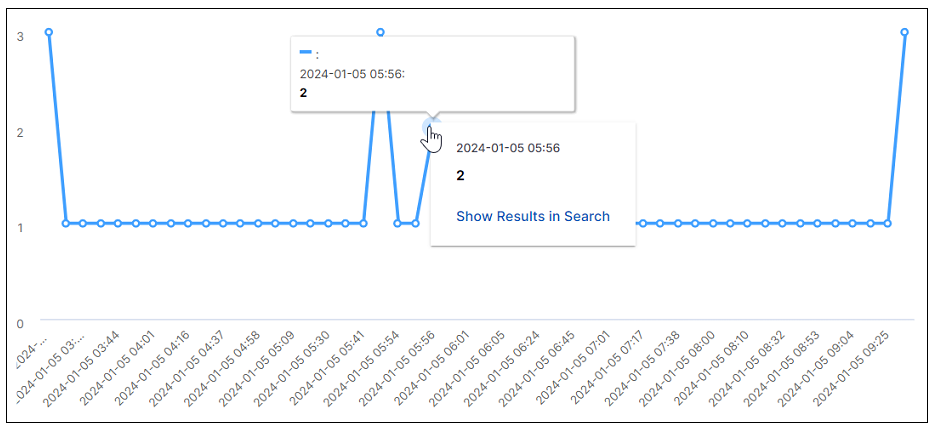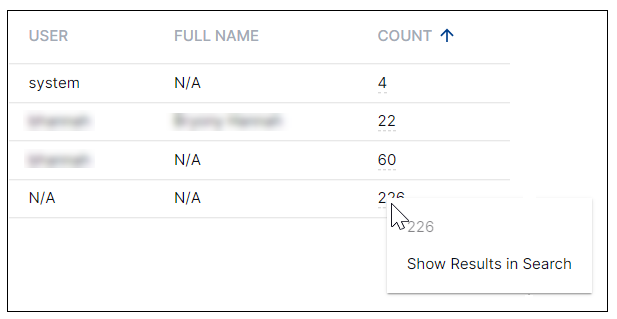- Dashboards
- Navigation Overview
- View and Interact with Dashboards
- View and Interact with Visualizations
- User Management
- Configure and Manage Dashboards
- Create a Dashboard
- Add a Visualization to a Dashboard
- Add a Text Tile
- Modify a Dashboard Layout
- Add Dashboard Filters
- Manage Automatic Refresh Rates
- Create a Scheduled Report
- Make a Dashboard Public
- Export and Import Dashboards
- Edit Dashboard Filters
- Edit Dashboard Details
- Duplicate a Dashboard
- Delete a Dashboard
- Configure and Manage Visualizations
- Create a Visualization
- Auto-Create a Visualization from a Natural Language Prompt
- Create a Visualization from a Search Query
- Add Visualizations from the Library to a Dashboard
- Modify a Visualization
- Configure Visualization Query Filters
- Include Context Filtering in Visualizations
- Make a Visualization Public
- Export and Import Visualizations
- Duplicate a Visualization
- Remove a Visualization from a Dashboard
- Delete Visualizations from the Library
- Configure and Manage Scheduled Reports
- Pre-Built Dashboards
- Advanced Analytics Dashboards
- AI/LLM Dashboards
- Case Manager Dashboards
- Compliance Dashboards
- Correlation Rules Dashboards
- Event Store Dashboards
- Access Grant and Revoke Activity
- Account Logout Summary
- Account Management Activity
- Application Security Event Summary
- Authenticated User Accounts on Hosts
- AWS CloudTrail Summary
- Data Loss Prevention Activity – Host-Based
- Data Loss Prevention Activity – User-Based
- Data Loss Prevention Activity Summary
- Default Account Access
- Default Credential Usage and Change Activity
- Denied Web Access Activity
- Disabled User Account Summary
- Discovered Attacks by Source and Destination
- Endpoint Detection and Response
- Failed Application Logon Activity
- Failed Audit Logs Summary
- Failed Host Login Attempt Counts by Users
- Failed VPN Login Attempts and Remote Session Timeouts
- Firewall Activity
- Firewall and Router Device Interfaces
- Insecure Authentication Attempts
- IOC Statistics
- Log Delay Insights
- Microsoft 365 Summary
- Microsoft Windows Overview
- Network Applications by Traffic Volume
- Policy Activity Summary
- Ports Usage Trend
- Privileged Access
- Privileged Access – User-Based
- Project Collateral
- Protocols by Network Traffic
- Remote Session Overview
- Security Alert Summary – Impacted Hosts
- Security Alert Summary – Origin Hosts
- Security Alert Summary – Users
- Successful Application Logon Activity
- Successful Database Login Activity
- Successful Physical Access
- Top Attackers
- User Account Creation Summary
- User Account Lockout Activity
- Vendor Authentication Activity
- Windows Audit Failure Summary by Hosts
- Windows Audit Failure Summary by Users
- Windows User Privilege Elevation
- Zscaler HTTP Dashboard
- Security Operations Center Management Dashboards
- Threat Center Dashboards
- Pre-Built Visualizations
- Anomalies - Use Case & MITRE Coverage
- Anomalies by Rule Name
- Anomalies by Use Case
- Anomalies Count Over Time
- Anomaly Distribution by MITRE Tactic & Score
- Application Count
- Closed Incidents
- Correlation Rules by Severity
- Correlation Rules Triggered Over Time
- Detected Anomalies
- Host-Based DLP Alerts Count
- Incidents Created
- Incident Summary by Incident Type
- Number of Hosts with DLP Alerts
- SOC Incident Distribution
- Top 5 Host-Based DLP Alert Categories
- Top 5 Protocols in Host-Based DLP Alerts
- Top 10 Host-Based DLP Alert Types
- Top 10 Hosts with DLP Alerts
- Top Activities per Top 10 Applications
- Top Users per Top 10 Applications
- Trend of Application Security Events
Failed Application Logon Activity
This dashboard provides an overview of failed application logon activity in your organization.
Note
This dashboard can assist you in complying with the following regulatory requirements: HIPAA 164.308-a1, NIST 800-66 R1 4.1.7, SOX/Control Activities/Authentication, GDPR 5.1.f, PCI 10.2.1, PCI 10.2.4, NIST 800-53 AC-2, NIST 800-53 AC-2(12), NIST CM-5(1), NIST 800-53 SI-4, CJIS 5.4.1.1
Time Range Filter
The Event : Approx Log Time filter sets the time range for the event data. The default setting is in the last 7 days. You can update this filter with a wide range of customizable settings.
To update the time range filter, click the arrow ( ) on the right, under the Edit button, to expand the filters panel. In the Event : Approx Log Time filter, select an operator from the first drop down menu and then enter or select values in the subsequent fields, depending on the operator you selected. To save your filter changes, click Apply on the right side of the filter panel. The updated filter is applied to the visualization.
) on the right, under the Edit button, to expand the filters panel. In the Event : Approx Log Time filter, select an operator from the first drop down menu and then enter or select values in the subsequent fields, depending on the operator you selected. To save your filter changes, click Apply on the right side of the filter panel. The updated filter is applied to the visualization.

Count of Users with Failed Application Logons
This single value bar chart displays the number of unique users with failed application logons within the selected time range.

Top 5 Reasons for Failed Application Logons
This pie chart illustrates the count proportions of the top five most common reasons that application logon attempts failed. To view the represented values, hover your pointer over the graph slices. To drill down into a value and view the underlying events, click the graph slice, and then click Show Results in Search.
 |
Top 5 Applications with Failed Logons
This pie chart illustrates the count proportions of the top five applications that have the most logon failures. To view the represented values, hover your pointer over the graph slices. To drill down into a value and view the underlying events, click the graph slice, and then click Show Results in Search.
 |
Failed Application Logon Activity Trends
This line graph shows the count trends of failed application activity over the selected time range. To view the values represented in the chart, hover your pointer over the graph lines to display the data points. To view the underlying events of a value, click the data point, and then click Show Results in Search.
 |
Top 10 Users with Failed Application Logons
This table provides details about the top 10 users with the most application logon failures, including user names and failure counts. Click the heading of the column that you want to sort the data by. Click the arrow icon to change between ascending ( ) and descending (
) and descending ( ) orders. To view all the table rows, you may need to use the scroll bar on the right.
) orders. To view all the table rows, you may need to use the scroll bar on the right.
To view the underlying events, in the Count column, click a count value and then click Show Results in Search.
 |
Recent Failed Application Logons
This table provides details on recent failed application logon events, including their times, subject, activity, outcomes, application, failure reason, source IPs, and object. Click the heading of the column that you want to sort the data by. Click the arrow icon to change between ascending ( ) and descending (
) and descending ( ) orders. To view all the table rows, you may need to use the scroll bar on the right.
) orders. To view all the table rows, you may need to use the scroll bar on the right.